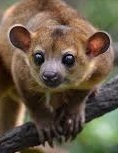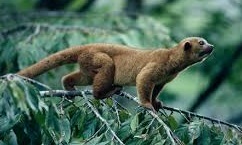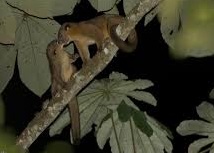
Kinkajou
(Potos flavus)

The kinkajou is a rainforest mammal of the family Procyonidae related to olingos, coatis, raccoons, and the ringtail and cacomistle. It is the only member of the genus Potos and is also known as the "honey bear" (a name that it shares with the sun bear). Kinkajous may be mistaken for ferrets or monkeys, but are not closely related to either. Native to Central America and South America, this mostly frugivorous, arboreal mammal is not an endangered species, though it is seldom seen by people because of its strict nocturnal habits. However, they are hunted for the pet trade, for their fur (to make wallets and horse saddles) and for their meat. The species has been included in Appendix III of CITES by Honduras, which means that exports from Honduras require an export permit and exports from other countries require a certificate of origin or re-export. They may live up to 40 years in captivity.
Conservation status
Least concern
Scientific classification |
|
| Kingdom: | Animalia |
| Phylum: | Chordata |
| Class: | Mammalia |
| Order: | Carnivora |
| Family: | Procyonidae |
| Genus: | Potos |
| Specie: | Potos flavus |
Description

An adult kinkajou weighs 1.4-4.6 kg (3-10 lb). The adult body length is 40-60 cm (16-24 in); in addition to body length, the length of the prehensile tail is 40-60 cm (16-24 in). The kinkajou's woolly fur consists of an outer coat of gold (or brownish-gray) overlapping a gray undercoat. It has large eyes and small ears. It also has short legs with five toes on each foot and sharp claws.
Range and habitat
Kinkajous range from east and south of the Sierra Madres in Mexico, throughout Central America to Bolivia east of the Andes and the Atlantic Forest of southeastern Brazil. Their altitudinal range is from sea level to 2500 m. They are found in closed-canopy tropical forests, including lowland rainforest, montane forest, dry forest, gallery forest and secondary forest. Deforestation is thus a potential threat to the species.Diet

Although the kinkajou is classified in the order Carnivora and has sharp teeth, its omnivorous diet consists mainly of fruit. Kinkajous particularly enjoy figs. Studies have shown that 90% of their diet consists of (primarily ripe) fruit. To eat softer fruits they hold it with their forepaws, then scoop out the succulent pulp with their tongue. They may play an important role in seed dispersal. Leaves, flowers, and various herbs make up much of the other 10% of their diet. They sometimes eat insects, particularly ants. It has been suggested, without direct evidence, that they may occasionally eat bird eggs and small vertebrates. Their frugivorous habits are actually convergent with those of (diurnal) spider monkeys.
The kinkajou's slender five-inch extrudable tongue helps the animal to obtain fruit and to lick nectar from flowers, so that it sometimes acts as a pollinator. (Nectar is also sometimes obtained by eating entire flowers.) Although captive specimens will avidly eat honey (hence the name "honey bear"), honey has not yet been observed in the diet of wild kinkajous.
Behavior

Kinkajous spent most of their life in trees, to which they are particularly well adapted. Like raccoons, kinkajous' remarkable manipulatory abilities rival those of primates. The kinkajou has a short-haired, fully prehensile tail (like some New World monkeys), which it uses as a "fifth hand" in climbing. It does not use its tail for grasping food. It can rotate its ankles and feet 180°, making it easy for the animal to run backward over tree limbs and climb down trees headfirst. Scent glands near the mouth, on the throat, and on the belly allow kinkajous to mark their territory and their travel routes. Kinkajous sleep in family units and groom one another. While they are usually solitary when foraging, they occasionally forage in small groups, and sometimes associate with olingos (which are also frugivorous).
A nocturnal animal, the kinkajou's peak activity is usually between about 7:00 PM and midnight, and again an hour before dawn. During daylight hours, kinkajous sleep in tree hollows or in shaded tangles of leaves, avoiding direct sunlight.
Kinkajous breed throughout the year, giving birth to one or occasionally two small babies after a gestation period of 112 to 118 days.
Reproduction

Originally, kinkajous were thought to be a solitary species that rarely exhibited sociality, but behavioral studies have revealed complex social interactions and an unusual mating system. Kinkajous exhibit both a polygamous and polyandrous mating system. Two males, a single female, and offspring often comprise a typical social group. The system is considered polygamous because dominant males mate with the female of their home group, as well as any other females living on the periphery of the home territory and unrelated to another group. Most copulation is done by the dominant male, but occasionally the subordinate male is allowed to copulate with the home group female. Genetic analysis of paternity supports the hypothesis that the dominant male monopolizes fertilizations.
During observed copulatory events, male kinkajous spent several hours following the female in oestrus, zigzagging over multiple hectares. Scent glands seem to be used for sexual stimulation and territorial marking. The subordinate male often follows closely, vocalizing and picking fights with the dominant male. Other observations have shown that both males occasionally copulate with the group female without displays of aggression. After copulation, the male and female disperse to different areas, probably to feed.
Zoológico de Vallarta A. C.
Leave your comments, your opinion is important to us

